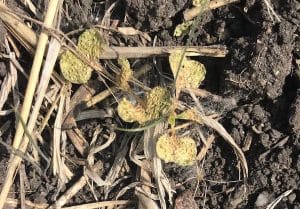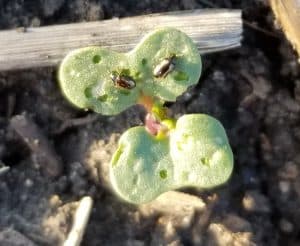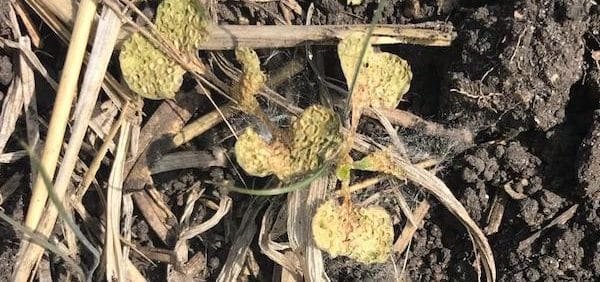The simplest reason seems the most logical: Warm and dry weather favours flea beetle emergence and activity. Warm temperatures increase flea beetle metabolism, which likely means more feeding per beetle. The same dry weather slows crop growth, leaving plants at a vulnerable small size for longer. Seedling feeding points also desiccate rapidly with warm and dry.
Very active flea beetles + slow-growing crop = lots of crops under heavier-than-usual flea beetle pressure.

This does not mean ‘spray sooner’ but pay close attention to the 25% defoliation action threshold. Damage can advance very quickly with dry and warm growing conditions AND with a large number of beetles active in the fields. So be prepared for ‘action’.

To dig deeper, we asked entomologists across the Prairies to help us answer a few questions:
Are there more flea beetles this year? They can’t say for sure. They may have some idea once sticky trap results from research studies are evaluated.
What risk factors can make flea beetles worse in a particular field? While canola seeded in canola stubble may be worse in some observations this year, Manitoba Agriculture entomologist John Gavloski is not aware of any research showing that rotation increases or decreases flea beetle risk. he says research has demonstrated lower flea beetle damage in canola in no-till fields compared to conventionally-tilled fields (Dosdall et al. 1999. Crop Protection 18: 217-224; Milbrath et al. 1995. The Canadian Entomologist 127: 289-293).
Is headland spraying a practical option? Headland spraying can be a practical option, providing there is a clear edge effect with the flea beetles in the field.
What insecticides are registered for foliar application for flea beetles? Foliar insecticides registered for flea beetles in canola are list on page 607 of the Manitoba and Saskatchewan Guides to Crop Protection. Note that Lorsban is not registered for flea beetles in canola. To Keep It Clean for export, it is important to always follow the instructions on product labels.
Further considerations:
Avoid going with the flow. Even if it seems everyone is spraying, it may not be the right decision for all fields. In areas where lots of spraying seems to be happening, two of our Saskatchewan agronomists checked their own canola fields and found minimal feeding. They’re not spraying. Check all fields. Know the thresholds. The ‘better safe than sorry’ approach may be a waste of time and money and unnecessarily threatens all the beneficial insects in a field. In some cases, you may also find that a headlands spray is enough. Flea beetles tend to be patchy and often worse at field edges.
If you plan to reseed, DON’T spray insecticide for flea beetles. By the time the next crop emerges, the flea beetles may have moved on to other more established crops nearby, and the reseeded crop will have some protection from its seed treatment.You may however want to spray herbicide to take out the old crop. That will allow for uptake of herbicide before the seeding step covers the small seedlings with a layer of dust.

